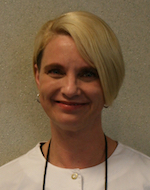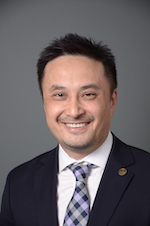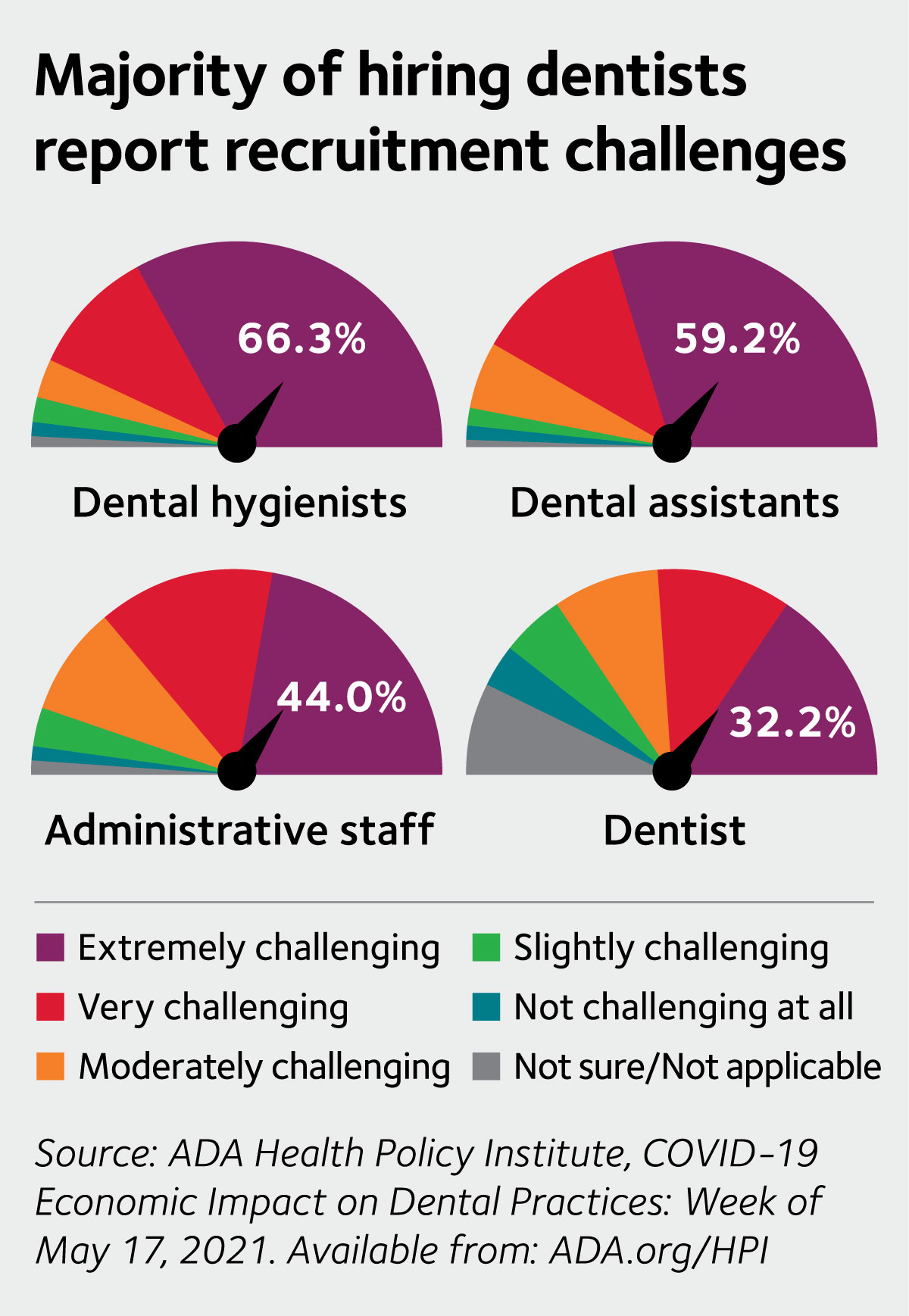Understaffed and ready to hire, dentists face applicant shortages as they emerge from COVID-19 pandemic



Before the COVID-19 pandemic, Rebecca De La Rosa, D.D.S., prided herself on having a tenured dental team.
But after losing two hygienists and an expanded-function assistant at the height of the pandemic — all of whom had been working for her for nearly 20 years — she has seen a limited number of job applicants and a revolving door of hires who have not lasted at her practice.
"Weeks pass without applicant submissions, and temporary staffing services have no availability," said Dr. De La Rosa, vice chair of the American Dental Association Council on Communications and owner of a dental practice in Avon, Indiana. "I have experienced interview no-shows and poor attendance from new hires. This reduction in staff in combination with COVID-19-related patient screening and slower operatory setup and teardown requirements has resulted in fewer patients being scheduled."
Dr. De La Rosa is not alone in the challenges she is facing as she attempts to fill open positions on her dental team — challenges the ADA is working to address.
A May poll from the ADA Health Policy Institute found 35.8% of owner dentists are recruiting dental assistants, 28.8% are seeking dental hygienists, 26.5% are looking to hire administrative staff and 13.1% are in search of associate dentists — all four percentages representing a rise in recruitment since October 2020.
Compared with before the pandemic, more than 80% of owner dentists who are currently hiring are finding the recruitment of dental hygienists and assistants to be extremely or very challenging:
- For dental hygienists, 66.3% of dentists said recruitment was extremely challenging and 19.7% reported it was very challenging.
- For dental assistants, 59.2% of dentists found recruitment to be extremely challenging and 23.9% stated it was very challenging.
Hiring of administrative staff and associate dentists has presented difficulties as well, with more than 70% of owner dentists saying recruitment of administrative staff was extremely or very challenging and more than 50% of owners reporting the same for recruiting associate dentists.

"The profession of dentistry, much like those of many other sectors of the economy, is facing severe workforce shortages in all facets of the team. And although these deficiencies can be found throughout the country, the challenges vary from state to state, with some complaining of a lack of available team members to others expressing concerns about exorbitant or unrealistic salaries for new hires," said Duc "Duke" M. Ho, D.D.S., chair of the ADA Council on Dental Practice. "Many shortages, especially in dental hygiene and chairside assistant, existed prior to the COVID-19 virus. However, these shortages have been exacerbated by the pandemic, as more employees have left the workforce for a variety of reasons, including early retirement, concerns about safety at the time and a desire for more work-life balance."
In an effort to help address some of these concerns, the ADA has resources available to support dentists who are facing staffing issues.
The Council on Dental Practice developed two promotional flyers intended to help recruit qualified people into allied dental careers. These resources are being shared with ADA members seeking personnel, state dental society staff, and high school and community vocational and educational programs, Dr. Ho said. The flyers, available at ADA.org/AlliedCareerFlyers, can be personalized for individual practices.
The ADA also has information and guidelines on managing the dental team, following a hiring process, leading a dental team during a pandemic and more at ADA.org/Staff.
Like Dr. De La Rosa, Michelle Steinhubel, D.D.S., who owns a dental practice in Everett, Washington, lost staff during the pandemic, including dental assistants and a scheduling coordinator.
"The response to ads placed online seems to be hit or miss; I have experienced a flood of applicants, and at other times, it is crickets — no response for days," Dr. Steinhubel said. "The inconsistency in response is difficult depending on how urgently you need to fill the position."
The people who do apply are sometimes seeking part-time as opposed to full-time employment, and some are new to the profession, requiring more on-the-job training.
"It is this sticky situation where we want to take in as many patients as we can to accommodate their needs, yet with working with fewer staff or training someone new, how can I as the employer take good care of both my patients and my team?" Dr. Steinhubel said.
Allison House, D.M.D., chair of the Council on Dental Practice's subcommittee on practice management, said the need for training can be difficult in the new normal created by the pandemic.
"The complexity of dental practice in 2021 has made it difficult to do on-the-job training with dental assistants and front office staff," she said. "While dentists are doing on-the-job training for these positions, it is not ideal."
Even before the pandemic, dental team members were in short supply, and the educational requirements for these positions could be part of the reason.
"Hygienists have been in short supply for a number of years," Dr. House said. "In most states, hygienists must have a license, and therefore it takes several years to graduate a qualified hygienist."
Dr. Steinhubel said there has been a shortage of both dental assistants and hygienists in her area for a few years. An assisting program closed, and a hygiene program was in danger of closing before finding a new facility, where it will be operating with a smaller number of students for at least the first year, she said.
"There aren't enough trained people to apply," Dr. Steinhubel said. "We were beginning to feel the pinch of fewer applicants already."
Dr. De La Rosa's employees have been approached by both headhunters and other dentists in the community with job offers. Headhunters reach out via social media and offer positions based on prior published work experience without personally meeting the candidates or checking references, she said. Her colleagues have reached out to her employees through word of mouth from their employees or others in the community.
"When an employee has given me their resignation notice, they find solace in indicating that they were approached for the position, not actively seeking one. Unfortunately, I have not experienced solace in knowing they have not sought employment elsewhere," said Dr. De La Rosa, who has been approached by a headhunter herself. "I have been left with the task of finding employees in a tight market during a pandemic."
Intense competition to fill openings has affected pay, which dentists say has been difficult as they recover from lower-than-normal patient volumes and rising overhead brought on by the pandemic.
HPI data from May show the majority of hiring dentists have raised the pay rates for dental assistants, hygienists and administrative staff since the pandemic began, with 73.1%, 70.7% and 67.1% increasing pay for assistants, hygienists and administrative staff, respectively.
Dr. Steinhubel has experienced the financial difficulties of increasing compensation rates while making additional purchases for her practice related to COVID-19, such as enhanced personal protective equipment, suction devices and air filters and purifiers.
"I'm sure many other dentists are in a similar situation where we feel the strain of catching up from our lost months of 2020 and managing quickly rising overhead costs on several different fronts while keeping our teams together and happy," she said.
It has been challenging to match the compensation requests of new applicants, who sometimes ask for pay outside the customary range for their experience and location, Dr. Steinhubel said. And she also has the paychecks of her current staff to support.
"The low supply of applicants has caused several offices to advertise higher pay rates, which has led to several of my team members requesting raises — despite recent raises given post-pandemic — because they reported they see higher rates advertised in ads in cities nearby and will look there if not given one," she said.
Dr. De La Rosa has also increased pay in response to the pandemic.
"I have always exercised and believed in a fair and competitive salary with generous benefits for my employees," she said. "The pandemic has raised the expected compensation significantly. To keep my practice operational, I have increased salaries, added part-time employees, increased time allotted for patient appointment times and increased fees."
When positions are left open, it affects the way dentists and their remaining team members operate.
"It creates much more pressure and stress on the entire office as each team member is asked to step outside their primary duties to help others, all with the aim of creating a smooth and seamless experience for the patient," Dr. Steinhubel said. "As a business owner, it is my responsibility to provide for my employees, and right now, striking that balance of ensuring they have enough support to do their jobs and ensuring the business stays profitable despite sky-rocketing costs of overhead, so their salaries can be paid, is difficult to say the least."
With full-time applicants scarce, she has hired part-time employees just to get some help, but she worries about the impact on her staff's work routine.
"This makes for a daily change in work pace where we used to strive for a consistent, even flow," Dr. Steinhubel said. "It's another strain that we can adapt to, of course, but it just means some days are pretty crazy compared with others."
To address the concerns of dentists and their team members, the ADA is working alongside its affiliate organizations, such as the American Dental Assistants Association and American Dental Hygienists' Association, to find outcomes that are mutually beneficial for the entire team, Dr. Ho said.
In a statement, the American Dental Assistants Association said it is monitoring the dental assistant shortage and taking steps to address it.
"The American Dental Assistants Association is aware and continually concerned with the shortage of dental assistants across the U.S.," the association stated. "We continue to provide occupational services and education to advance dental assisting in America. Many factors have contributed to these shortages, such as low wages and long hours with additional responsibilities and PPE. Dental assisting is a highly skilled profession requiring education and training. We will continue to monitor and address these concerns and look forward to working with the dental community to explore solutions that advance the profession."
The ADA and American Dental Hygienists' Association are working together to research U.S. dental hygienists' employment patterns during the COVID-19 pandemic, as well as their infection rates and infection control practices.
As of late April, 3.8% of the surveyed dental hygienists who had been employed as of March 2020 were not currently working — the lowest unemployment rate since the start of the survey — with 66% of them leaving their positions voluntarily. According to survey data from March 1, 6.8% of dental hygienists had contracted COVID-19 since the start of the pandemic, lower than estimates for other health care workers and the general population.
"The health and safety of the entire dental team, their patients and families has been first and foremost," said Ann Battrell, CEO of the American Dental Hygienists' Association. "Many dental hygienists had questions and concerns about COVID-19 and rightly so. Some dental hygienists were faced with the very personal decision about returning to work in the face of the pandemic. Our most recent data indicate that for dental hygienists who have voluntarily left their positions, 42.9% reported, 'I do not want to work as a dental hygienist until after the COVID-19 pandemic is under control.' Another 38.1% stated, 'I have concerns about my employer's adherence to workplace/safety standards.' We are pleased that with adherence to the Centers for Disease Control and Prevention guidance, including proper PPE, dental hygienists can practice safely. Communication among the dental team is more important now than ever. As health care professionals, we need to support one another as we continue to navigate through this pandemic."
More dental hygienists returning to practice is a positive sign for dentists seeking to hire staff. But Dr. Ho said he knows addressing the staffing shortages and hiring challenges dentists are facing will take time.
"This is a big problem that will not be solved overnight," he said. "The Council on Dental Practice, as well as the ADA, is open to all suggestions, especially those outside the box, to tackle these workforce shortages."
Dr. De La Rosa said she is heartened by the efforts of the ADA and her local and state dental associations to address the COVID-19 pandemic and its effects on the dental profession, including staffing issues.
When facing professional challenges in the past, she has found that being open to change, keeping a positive outlook and leaning on available resources have helped her make sound decisions, develop tangible solutions and maintain her practice and patient-centered values. She is confident she can do that again.
"I am certain that the future will be bright," Dr. De La Rosa said.



